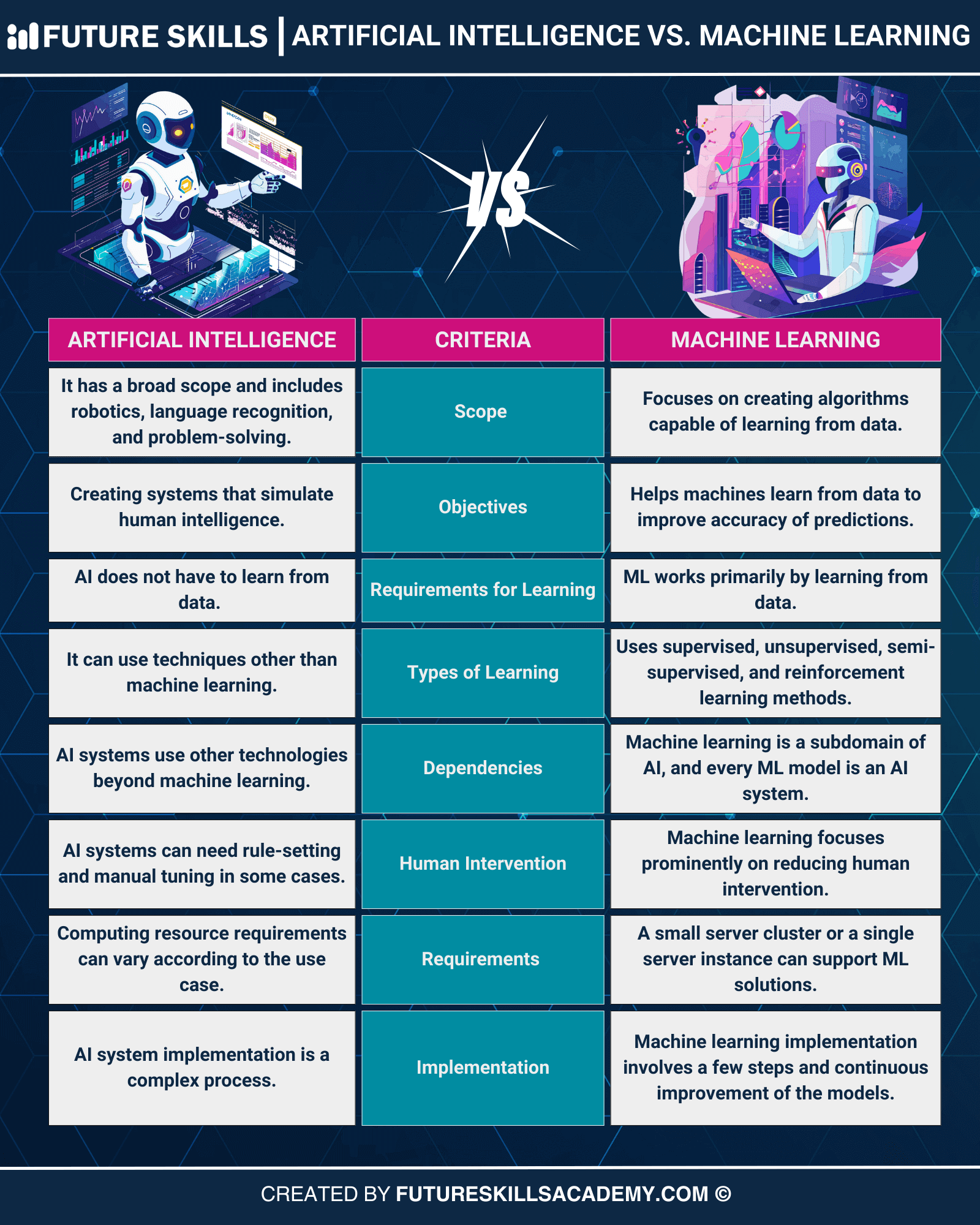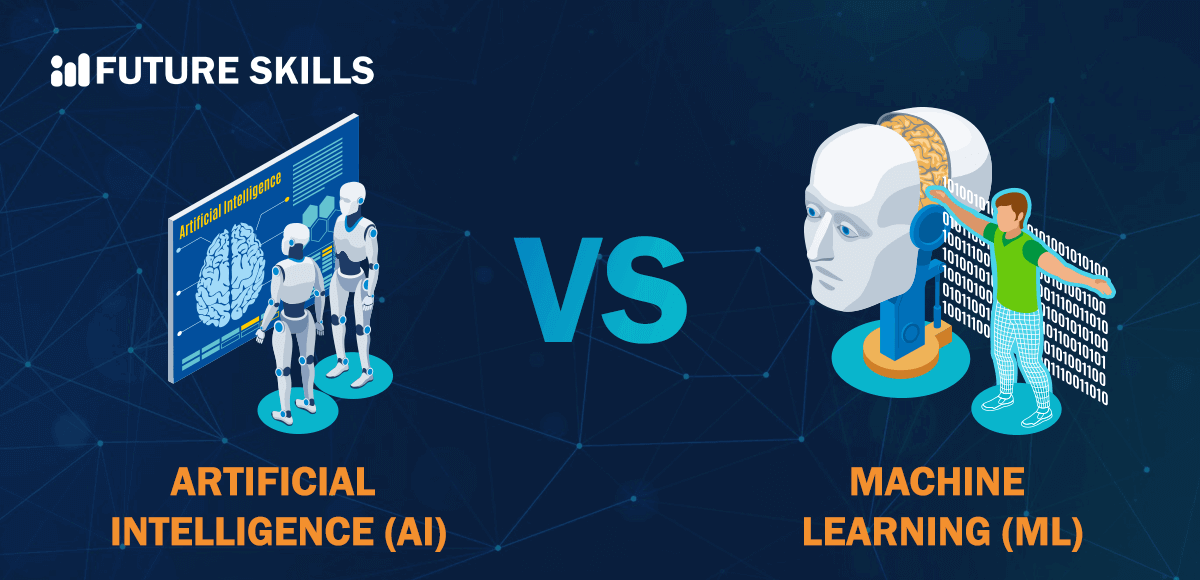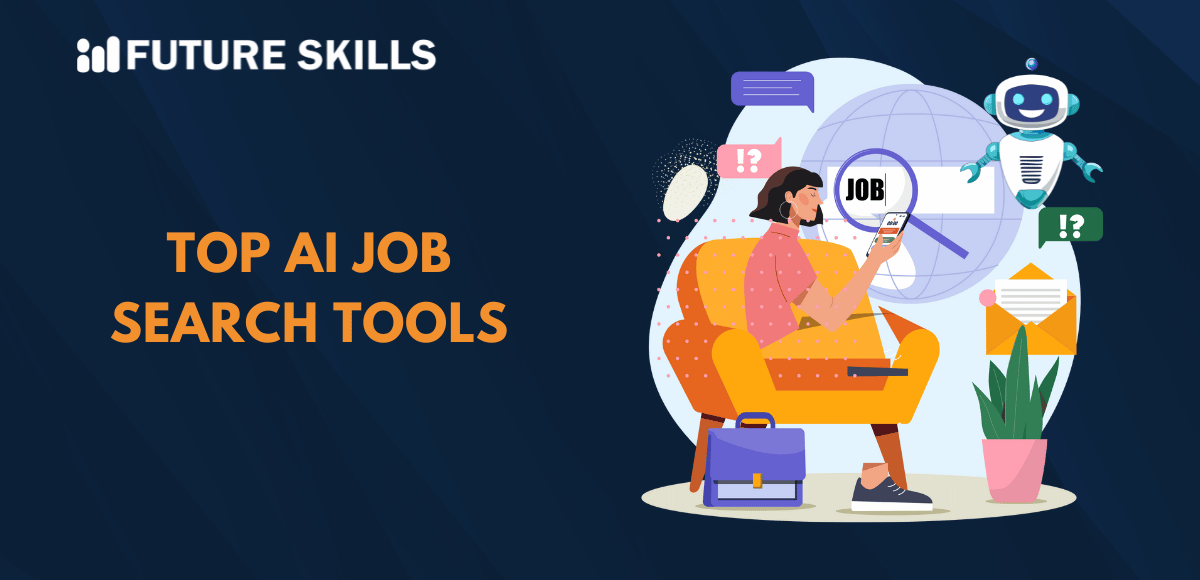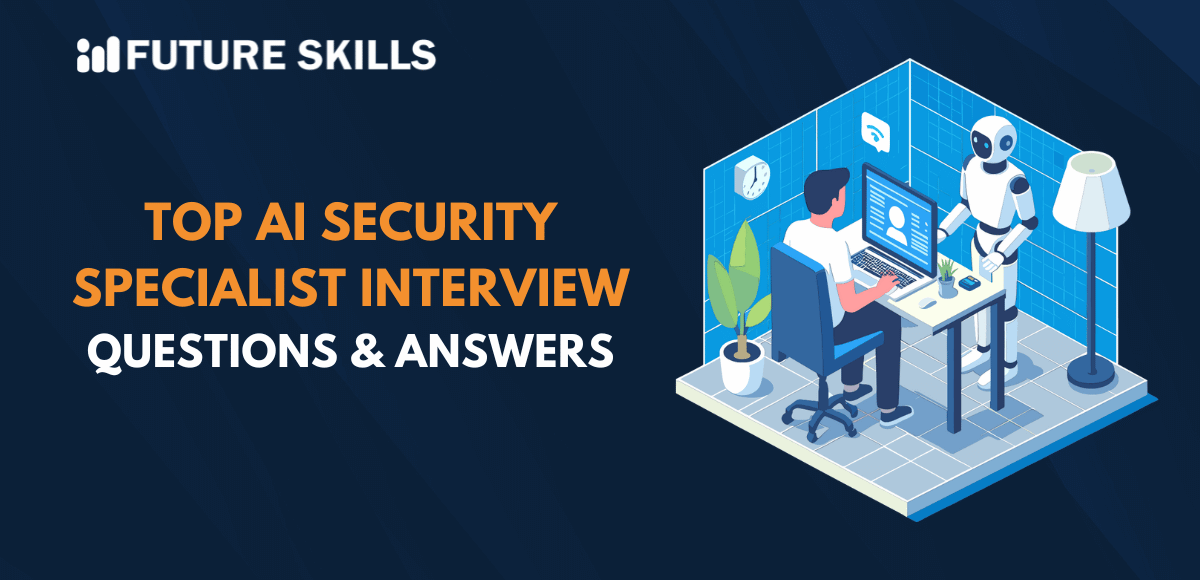The rapid pace of advancements in the domain of technology has been commendable. The two most prominent terms that have gained momentum in recent times are artificial intelligence and machine learning. You might have heard people using the terms machine learning and artificial intelligence in discussions about predictive analytics, big data, and other crucial topics for digital transformation. It is also important to note that people use both terms interchangeably due to the interrelationship between them.
However, AI and ML are different in terms of scope, applications, and many other aspects. Artificial intelligence points to the ability of computers to simulate human intelligence for performing different tasks in real-world environments. On the other hand, machine learning refers to algorithms and technologies that help computers with identification of patterns, making decisions, and continuous improvement.
Artificial intelligence and machine learning are no longer restricted to discussions about innovative technologies that can build the future. As a matter of fact, both technologies are creating the future, as you can see from this post. AI and ML have transformed industries like healthcare, retail, finance, and many more.
However, the AI vs. ML debate is also crucial for beginners in AI and ML, as well as expert professionals. The difference between AI and ML can help you understand the best ways to leverage the technologies for your benefit. In this post, we will find out the definitions of artificial intelligence and ML, as well as the differences and similarities between them.
Level up your AI skills and embark on a journey to build a successful career in AI with our Certified AI Professional (CAIP)™ program.
Definition of Artificial Intelligence
Artificial intelligence is a broad term and encompasses the use of different types of technologies. It primarily focuses on using technologies to develop computer systems and machines that can replicate human intelligence. In simple words, the AI vs. ML debate must focus on ability of AI to induce cognitive capabilities in machines.
For example, AI can help machines visualize, understand, and respond to written or spoken language. It can also empower machines for data analysis and prediction generation. Artificial intelligence is not a singular technology or system. As a matter of fact, it represents a set of technologies used in a computer system or machine to help it with reasoning, learning, and action to solve complex problems.
What are the technologies used by AI? Artificial intelligence systems utilize tools such as machine learning, neural networks, deep learning, natural language processing, and computer vision. You can notice how machine learning is one of the major technologies empowering AI systems.
Level up your ChatGPT skills and kickstart your journey towards superhuman capabilities with Free ChatGPT and AI Fundamental Course.
Definition of Machine Learning
The relationship between AI and ML invites attention to the nature and purpose of machine learning. Interestingly, the AI and ML difference is clearly evident in the fact that machine learning is a subdomain of artificial intelligence. Machine learning is one of the technologies that enables the creation of advanced AI systems. Machine learning utilizes algorithms rather than relying on explicit programming for analysis of large volumes of data and learning from the insights to make informed decisions.
Another important piece of information about the working machine learning algorithms is the way in which they improve over time. Course algorithms improve continuously as they process more data. Machine learning models are optimized according to the algorithm’s learnings from the training data. Using more data on machine learning algorithms can ensure improvement in accuracy and performance of ML models.
Are Artificial Intelligence and Machine Learning Similar to Each Other?
The relationship between AI and ML invites curiosity about the similarities between the two innovative technologies. You should think of the similarities between a search engine like Google and Nature. Both of them rely on artificial intelligence. Search engines obviously need AI to improve their functionalities, while nature needs artificial intelligence to capitalize on innovative advancements. Machine learning plays a crucial role in accelerating the advancement of artificial intelligence to the extent that it can influence the world around us.
The ML vs. AI comparisons should also emphasize the similarities between them. An in-depth understanding of similarities between AI and ML can help in making the most of the two technologies. You can find the following similarities between ML and AI.
Artificial intelligence and machine learning focus on automating tasks that require human effort, such as decision-making or data analysis.
Both AI and machine learning depend largely on data for their work. Artificial intelligence utilizes data to make informed decisions. On the other hand, machine learning utilizes data for continuous learning and improvement.
Speaking of improvement, the AI vs. ML debate also draws attention to how both of them improve continuously with time. Artificial intelligence systems can improve their effectiveness by gathering more data. At the same time, machine learning algorithms can also improve their performance by being exposed to more data during the training.
Another notable similarity between artificial intelligence and machine learning emphasizes their interdisciplinary nature. AI and ML feature elements from different disciplines, such as computer science, engineering, mathematics, and statistics.
The discussions on similarities between machine learning and artificial intelligence also point towards the requirement of a lot of computational resources. You would need specialized resources such as GPUs for complex tasks in machine learning and AI.
Artificial intelligence and machine learning are similar in terms of their capabilities for solving problems similar to humans. Therefore, you can find cross-industry applications of both technologies. For example, artificial intelligence can help optimize supply chains, improve agricultural outcomes, and predict sports outcomes. At the same time, machine learning also serves use cases in predictive machinery maintenance, insurance fraud detection, demand forecasting, and dynamic travel pricing.
Excited to understand the crucial requirements for developing responsible AI and the implications of privacy and security in AI, Enroll now in the Ethics of Artificial Intelligence (AI) Course
Unraveling the Difference between Artificial Intelligence and Machine Learning
The similarities between AI and ML present one side of the potential capabilities of both technologies. However, answers to “What is difference between artificial intelligence and machine learning?” can have a significant impact on demystifying AI and ML.
The comparison of differences between AI and ML can help in breaking down the complex aspects of the technologies into understandable insights. You can be a business leader or a beginner in data science and make the most of a clear understanding of differences between AI and ML. Here is an overview of the differences between artificial intelligence and machine learning.

-
Scope
The foremost element in an AI vs. ML comparison is the scope of the technologies. Artificial intelligence has a broader scope as it encompasses everything that helps computer systems replicate human intelligence. For example, the scope of AI includes solutions such as language recognition, robotics, and problem-solving. On the other hand, the scope of machine learning revolves primarily around developing algorithms that are capable of learning from data.
-
Objectives
The objectives of AI and ML also serve as an important benchmark for comparing the two technologies. The discussions about AI vs. ML comparison showcase that the primary objective of AI focuses on creating systems that can simulate human intelligence. Machine learning can help machines learn from data to empower them to make accurate predictions and make right decisions.
The objective of AI systems revolves around ensuring that a machine can complete complex human tasks with efficiency. For example, artificial intelligence can conduct tasks such as pattern recognition, learning, and problem-solving. On the other side, machine learning involves machines analyzing massive volumes of data. The machines would utilize statistical models for identifying patterns in the training data.
-
Requirement for Learning
The requirement for learning in AI and ML difference table also highlights another crucial parameter for differentiating the two technologies. Artificial intelligence systems don’t have to depend on learning from different types of training data. For example, rule-based AI systems can make decisions on the basis of a collection of explicitly specified rules. Machine learning focuses heavily on learning from data. Availability of more data for machine learning algorithms guarantees better learning and continuous improvement of machine learning models.
Enroll now in the AI for Business Course to understand the role and benefits of AI in business and the integration of AI in business.
-
Types of Learning Approaches
Artificial intelligence systems can follow a rule-based learning approach or avoid learning from data. In addition, the responses to “What is difference between artificial intelligence and machine learning?” shed light on how AI uses different types of learning approaches without being restricted to techniques in machine learning.
On the other hand, machine learning follows different approaches, such as supervised learning, unsupervised learning, semi-supervised learning, and reinforcement learning. Artificial intelligence utilizes different types of methods for solving diverse issues. Some of the notable methods used in AI include genetic algorithms, search algorithms, machine learning, deep learning, rule-based systems, and neural networks.
-
Dependencies
Another crucial aspect in the outline of differences between machine learning and AI is the dependency between both of them. Most people use AI and ML interchangeably as they think both of them represent the same technology. However, the biggest highlight in any ML vs. AI comparison is the fact that machine learning is a subset of AI. Therefore, all types of machine learning can be classified as AI. On the other hand, you cannot associate every AI system with machine learning, as AI systems can also use other technologies.
-
Need for Human Intervention
The comparison between artificial intelligence and machine learning also invites attention to the element of human intervention. It is important to note that artificial intelligence systems are not completely autonomous and could require human intervention to a certain extent.
For example, some AI systems are completely autonomous, while others may need rule-setting and manual tuning. On the other side of the debate, machine learning focuses specifically on achieving maximum reduction of human intervention. As a matter of fact, machine learning can improve to the extent of automation of the process through which it learns from data.
-
Requirements
The AI vs. machine learning debate also rounds up the requirements for implementing the two technologies. Machine learning solutions need massive datasets with multiple data points that they can use for training. In addition, ML models also need massive amounts of computational resources to accomplish the desired tasks.
For some applications or use cases, ML models can accomplish their goals with a small server cluster or a single server instance. On the other hand, AI systems can have a wide range of infrastructure requirements, depending on the use case and the technique. For instance, you would need multiple machines working in collaboration to achieve complex goals in use cases that demand intensive computing.
-
Implementation
The answers to “How can you implement AI and ML?” also provide a helpful suggestion for comparing AI and ML. You must note that the process of developing an ML solution involves two steps only. First of all, you have to prepare the training dataset. In the second step, you have to choose a predefined ML model, such as a decision tree or linear regression.
Subsequently, data scientists can choose the important data features and use them in the model for training purposes. Data scientists must also refine the dataset continuously by checking errors and updating data. On the other hand, developing an AI solution can be extremely complex, and most people choose predefined AI solutions.
Final Words
The review of the differences between machine learning and artificial intelligence shows that they are interrelated yet completely different technologies. Artificial intelligence focuses on the use of different techniques to help machines accomplish tasks that would require cognitive abilities or intelligence like humans. On the other side, machine learning involves continuously learning from training data to improve the accuracy and performance of machines in making predictions. Learn more about machine learning and AI fundamentals right now.





